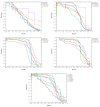Object Detection of Flexible Objects with Arbitrary Orientation Based on Rotation-Adaptive YOLOv5
- PMID: 37430839
- PMCID: PMC10223194
- DOI: 10.3390/s23104925
Object Detection of Flexible Objects with Arbitrary Orientation Based on Rotation-Adaptive YOLOv5
Abstract
It is challenging to accurately detect flexible objects with arbitrary orientation from monitoring images in power grid maintenance and inspection sites. This is because these images exhibit a significant imbalance between the foreground and background, which can lead to low detection accuracy when using a horizontal bounding box (HBB) as the detector in general object detection algorithms. Existing multi-oriented detection algorithms that use irregular polygons as the detector can improve accuracy to some extent, but their accuracy is limited due to boundary problems during the training process. This paper proposes a rotation-adaptive YOLOv5 (R_YOLOv5) with a rotated bounding box (RBB) to detect flexible objects with arbitrary orientation, effectively addressing the above issues and achieving high accuracy. Firstly, a long-side representation method is used to add the degree of freedom (DOF) for bounding boxes, enabling accurate detection of flexible objects with large spans, deformable shapes, and small foreground-to-background ratios. Furthermore, the further boundary problem induced by the proposed bounding box strategy is overcome by using classification discretization and symmetric function mapping methods. Finally, the loss function is optimized to ensure training convergence for the new bounding box. To meet various practical requirements, we propose four models with different scales based on YOLOv5, namely R_YOLOv5s, R_YOLOv5m, R_YOLOv5l, and R_YOLOv5x. Experimental results demonstrate that these four models achieve mean average precision (mAP) values of 0.712, 0.731, 0.736, and 0.745 on the DOTA-v1.5 dataset and 0.579, 0.629, 0.689, and 0.713 on our self-built FO dataset, exhibiting higher recognition accuracy and a stronger generalization ability. Among them, R_YOLOv5x achieves a mAP that is about 6.84% higher than ReDet on the DOTAv-1.5 dataset and at least 2% higher than the original YOLOv5 model on the FO dataset.
Keywords: YOLOv5; flexible objects with arbitrary orientation; object detection; power grid maintenance and inspection site.
Conflict of interest statement
The authors declare no conflict of interest.
Figures










Similar articles
-
Corner-Point and Foreground-Area IoU Loss: Better Localization of Small Objects in Bounding Box Regression.Sensors (Basel). 2023 May 22;23(10):4961. doi: 10.3390/s23104961. Sensors (Basel). 2023. PMID: 37430876 Free PMC article.
-
Enhanced YOLOv5: An Efficient Road Object Detection Method.Sensors (Basel). 2023 Oct 10;23(20):8355. doi: 10.3390/s23208355. Sensors (Basel). 2023. PMID: 37896450 Free PMC article.
-
Object Detection Method for Grasping Robot Based on Improved YOLOv5.Micromachines (Basel). 2021 Oct 20;12(11):1273. doi: 10.3390/mi12111273. Micromachines (Basel). 2021. PMID: 34832685 Free PMC article.
-
Bolt Positioning Detection Based on Improved YOLOv5 for Bridge Structural Health Monitoring.Sensors (Basel). 2022 Dec 30;23(1):396. doi: 10.3390/s23010396. Sensors (Basel). 2022. PMID: 36616994 Free PMC article.
-
R-YOLO: A YOLO-Based Method for Arbitrary-Oriented Target Detection in High-Resolution Remote Sensing Images.Sensors (Basel). 2022 Jul 30;22(15):5716. doi: 10.3390/s22155716. Sensors (Basel). 2022. PMID: 35957272 Free PMC article.
References
-
- Xie T., Wang K., Li R., Tang X., Zhao L. Panet: A pixel-level attention network for 6d pose estimation with embedding vector features. IEEE Robot. Autom. Lett. 2021;7:1840–1847. doi: 10.1109/LRA.2021.3136873. - DOI
-
- Girshick R., Donahue J., Darrell T., Malik J. Rich feature hierarchies for accurate object detection and semantic segmentation; Proceedings of the IEEE Conference on Computer Vision and Pattern Recognition; Columbus, OH, USA. 23–28 June 2014; pp. 580–587.
Grants and funding
LinkOut - more resources
Full Text Sources

